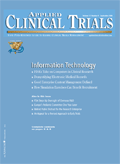A Revised Approach to Early Trials
Applied Clinical Trials
Finding new ways to design and conduct clinical trials in order to prevent Phase III failures.
Companies with the fastest time to market are also the most likely to stop development early. Considerable skill is required to identify failing compounds and the evidence is rarely clear cut. So the question arises: How many of these abandoned molecules would have demonstrated interesting properties if more detailed studies had been possible at an early stage? The industry needs to be open to new ways of designing and conducting early trials. However, while there is growing interest in using patients before Phase II, the practice is very limited.
Early involvement of patients provides insights that healthy volunteers cannot. It is known that many diseases change the patients' physiology. For example, Parkinson's disease alters gastrointestinal transit times, influencing drug absorption, and the blood–brain barrier is also abnormal, altering passage of compounds into the brain. In view of these differences, data generated only in healthy volunteers may lead to erroneous conclusions about the likely behavior of a drug.

Anthony Priestley, MD
Ethical arguments may also direct a company toward Phase I patient studies. Development of cytotoxic compounds is an obvious example. Some drugs in development, particularly biotechnology products, are directed against targets not significantly expressed in healthy volunteers. This may radically alter the compound's pharmacokinetic profile, reducing the data's validity.
There is a concern that when using patients the trial population will be so small that the data will have little significance. This is becoming less important as the use of statistical techniques such as simulation and modeling become better understood. And although Phase I studies are usually too short to establish efficacy, many potential biomarkers can help establish that a drug has reached its target and demonstrated the predicted response.
So why the continued reluctance to involve patients at an early stage? A key concern is that the time scales are longer and less predictable than for trials with healthy volunteers. Within an organization that is hardwired to believe that time is the enemy, it is difficult to argue whether the value of the data produced merits the additional time taken to reach that point.
The second concern is that the data are less easy to interpret, particularly within the regulatory environment. Volunteer studies are well understood, as there have been so many. Patient studies can vary significantly, and the definition of a disease is not consistent between different regulatory regimes.
So how can the industry move on? Firstly, it cannot continue to tolerate the high rate of Phase III failures or miss the opportunities created by more personalized and gene specific therapies. That said, I think that we will begin to see different CROs specializing in a particular therapeutic area and forming close links with consultants and general practitioners in order to source and support small-scale patient studies to run in parallel with the larger healthy volunteer trials.
In practice, the decision to use patients or healthy volunteers must be taken on an individual basis since each compound is unique and every therapeutic area offers different challenges. But there is a growing consensus that some combination of the two would help secure a carefully crafted dataset from which to determine with confidence the likely success of a compound on the basis of Phase I data.

Putting Collective Insights Into Action to Advance Cancer Care: Key Examples From ASCO 2025
June 27th 2025At ASCO 2025, clinical operations leaders gained critical insights into how AI tools, bispecific antibodies, and evolving treatment paradigms are reshaping trial design, endpoint selection, and patient stratification.